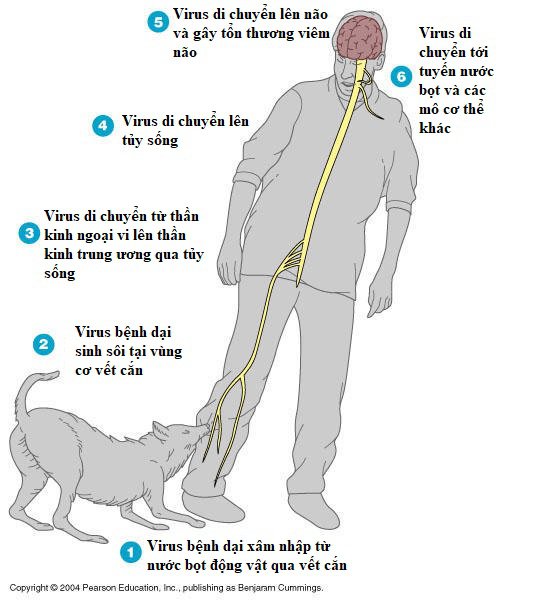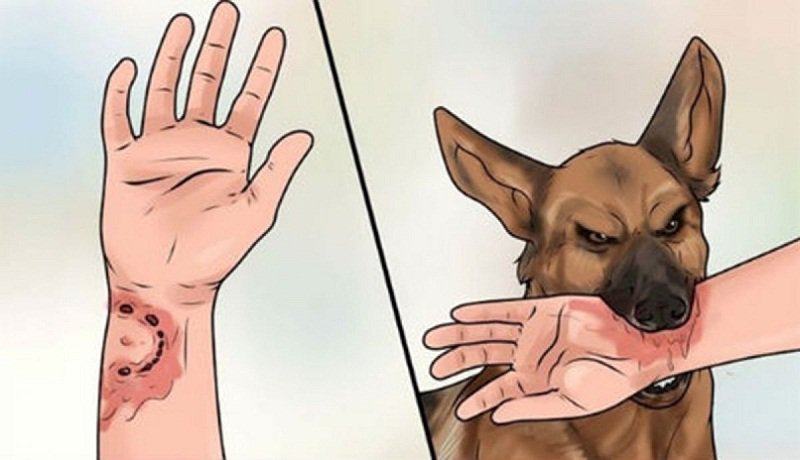Rabies is a rare infection but has very serious consequences in the brain and nerves. The disease is often caught from bites or scratches of infected animals, usually dogs.
1. Duration of development of rabies
Rabies symptoms in humans can occur quickly in the first week after viral infection.
The initial symptoms of rabies are generalized, including a weak body, fever and headache. Without a history of exposure to rabies animals, these symptoms will not increase suspicion of rabies because they are very similar to the common flu or other viral syndromes.
2. How does rabies develop in humans?
After entering the human body, the rabies virus develops in the inner layer of tissue underneath the human skin (called the lower skin tissue), or from the muscles, into the peripheral nerves (i.e. nerves in the body that are outside the brain or spinal cord).
The virus moves along the nerves to the spinal cord and brain at an estimated rate of 12-24 mm per day.

Infected people show changes in behavior and clinical signs when the virus enters the brain.
The incubation period ranges from a few days to several months, and can be up to 1 year long.
3. Can rabies in humans be cured?
There is no specific treatment when rabies develops. Almost nothing can be done other than keeping the patient comfortable, and free from physical pain and emotional discomfort.
- Caregivers should exercise caution to avoid bites and salivary infections of mucous membranes and wounds using personal medical protective equipment.
- Keeping patients in a quiet room with soft lighting and protecting them from sitations (e.g., loud noise, cold air) is likely to increase spasms and seizures.
- Sedating with diazepam 10 mg every 4 hours 6 hours, supplemented by chlorpromazine 50 iron 100 mg or intravenous morphine if necessary will help control muscle spasms and be prone to irritation.
- Oral feeding is often impossible. Fluids should be given intravenously.
4. What to do when rabies is suspected?
4.1 Treatment of wounds after a bite
- The wound should be washed and washed immediately with soap and water for 10–15 minutes. If soap is not available then flush. This is the job that helps first aid most effectively risk rabies.
- The wound should be thoroughly cleaned with 70% alcohol/ethanol or povidone-iodine (if any).

- As soon as possible, take the person to a healthcare facility to continue treatment.
Things to avoid: Apply stimulants to wounds such as paprika, plant juices, acids or alkalis. Bandage the wound with wound gauze.
4.2 Tracking of animals causing wounds
The incubation period of rabies from a few days to several months, while the period of illness – until death – varies from 1 to 7 days.
Dog rabies is characterized by changes from its normal behavior, such as:
- Bite without any provocation
- Eat unusual objects such as sticks, nails, feces, etc.
- Run without a clear purpose
- Change the sound, for example, hoarseness and growl or inability to make sounds
- Excessive salivation or foaming in the corners of the mouth – but not hydrophobia (water scare).
4.3 Monitoring the signs of the disease on the human body
This helps to best prepare preventive measures for the disease, common manifestations before the ons of the disease include:
- Pain or itching at the site of a bite wound (in 80% of cases)
- Fever, discomfort, headache last for 2-4 days

- Water scare
- Noise, light or air intolerance
- Fear of imminent death
- Anger, discomfort and depression
- At a later stage, spasm irritation is visible only in the neck and throat
4.4 Rabies vaccination (PEP)
Prevention of post-exposure rabies (PEP) is mandatory if you have been bitten by a dog, cat or other animal with rabies or suspected rabies infection. PEP is required under the following conditions:
If the bite has ruptured the skin and the wound is bleeding.
If the mucous membrane is in contact with saliva from a suspected animal.
If the animal has bitten someone:
- Killed
- Disappears during observation
- Display unusual, erratic behavior
- If laboratory testing of brain material from suspected or rabid animals is positive.
Rabies vaccination of pets is a way to prevent rabies from spreading to humans. Pet families need to vaccinate dogs at 6-8 weeks of age and vaccinate cats at 8 weeks of age or according to the instructions of a veterinarian.
For direct advice, please click hotline number or register online HERE. In addition, you can register for remote consultation HERE
- Not only is it transmitted through bites, rabies is also transmitted through the saliva of the animal
- Recognition of initial manifestations of rabies in humans
- How long does the rabies vaccine work?

